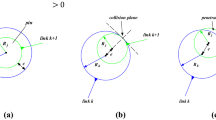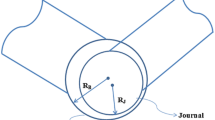Abstract
With continuous improvements being made in science, technology, and production automation, robotics is becoming increasingly popular in the field of automation. Robotics has the potential to improve work efficiency, reduce production cost, protect humans from adverse conditions, and increase production scale. A three-dimensional (3D) printed amphibious spherical robot was designed to operate in various environments with a wide-range of complex conditions over a long period of time. The compact, fully waterproof design has the advantages of a reduced manufacturing time, high efficiency, good mobility, low noise, and reliable stability. This study considers how some of the more critical components of the robot, such as its leg brackets, circular middle plate, and spherical shell, respond to large dynamic stresses, shocks, and vibrations during operation; this can lead to reduced precision of the robot’s locomotion and may cause critical components to become damaged or fail. To design the robot with a more rigid structure and improved dynamic characteristics, 3D models of the critical components were constructed with SolidWorks. Using ANSYS WORKBENCH software, these models were incorporated into the robot design to determine the natural frequencies and the associated mode shapes of the first six orders. The procedure and analysis results are described in this paper. The fatigue life of these critical components was examined using the cyclic load spectrum and cyclic stress as a function of number of cycles to failure (S–N curve) of acrylonitrile butadiene styrene plastic, the construction material for the robot. Finite element analysis was used for design optimization relevant to fatigue life, damage, safety, and fatigue sensitivity, and the weak areas in the components were identified. The approach described herein provides a theoretical basis for robotics design optimization.


















Similar content being viewed by others
References
Bae JH, Kim MS, Song MJ, Jung SY, Kim C (2011) A study on optimal design and fatigue life of the common rail pipe. Int J Precis Eng Manuf 12(3):475–483
Bayo E, Papadopoulos P, Stubbe J, Serna MA (1989) Inverse dynamics and kinematics of multi-link elastic robots-an iterative frequency-domain approach. Int J Robot Res 8(6):49–62
Cho JR, Jeong KY, Park MH, Shin DS, Lim OK, Park NG (2013) Finite element structural analysis of wind turbine gearbox considering tooth contact of internal gear system. J Mech Sci Technol 27(7):2053–2059
Du Z, Yu Y (2007) Research on dynamic stress and endurance characteristics of flexible robots. China Mech Eng 18(24):2985–2989
Feng Y, Zhao J, Chen S (2012) Modal analysis of spiral bevel gear of large power reducer. J Mech Transm 2012(3):78–80. doi:10.16578/j.issn.1004.2539.2012.03.020
Ghaffari MA, Hosseini-Toudeshky H (2013) Fatigue crack propagation analysis of repaired pipes with composite patch under cyclic pressure. J Press Vessel Technol Trans ASME 135(3):031402. doi:10.1115/1.4023568
Gok A, Inal S, Taspinar F, Gulbandilar E, Gok K (2014) Fatigue behaviors of different materials for schanz screws in femoral fracture model using finite element analysis. Optoelectroin and Adv Mater Rapid Commun 8(5–6):576–580
Gong W, Huang M, Zhang M, Ye L, Tang L (2014) Calculation modal analysis based on ANSYS workbench and experiment research of flip chip bonder sheet metal parts. J Mach Design 31(8):101–105
Guo S, Shi L, Mao S, Li M (2012) Design and kinematic analysis of an amphibious spherical robot. In: 2012 IEEE International Conference on Mechatronics and Automation, Chengdu, pp 2214–2219
Hao K, Ping X, Li W (2014) Structural design and analysis of cartesian transfer robot used in furnace based on Pro/E and workbench. J Mech Transm 38(7):100–103
Harmain GA (2010) A model for predicting the retardation effect following a single overload. Theor Appl Fract Mech 53(1):80–88
He Y, Guo S, Shi L (2014) 3D printing technology-based an amphibious spherical underwater robot. In: 2014 IEEE International Conference on Mechatronics and Automation. IEEE, Tianjin, pp 1382–1387. doi:10.1109/ICMA.2014.6885901
He Y, Shi L, Guo S, Pan S, Wang Z (2016) Preliminary mechanical analysis of an improved amphibious spherical father robot. Microsyst Technol 22(8):2051–2066. doi:10.1007/s00542-015-2504-9
Huang H, Zhu S, Wang Z, Hou M, Fan Z, Zhou L (2011) Nonlinear fatigue damage cumulative rule based on strength degradation and its application to fatigue life reliability analysis. J Basic Sci Eng 19(2):323–334
Li H, Wei Y, Shi J, Liang F (2014) The finite element analysis of pressure vessel wall thickness. J Yunnan Agric Univ 29(4):549–552
Lu S, Guo C, Dai Z (2012) Design and optimization of robot foot structure of bionic locust's pads. Chin Sci Bull 57(26):2463–2468
Mayer H, Stark HL, Ambrose S (2000) Review of fatigue design procedures for pressure vessels. Int J Press Vessels Pip 77(13):775–781
Miclosina CO, Campian CV (2012) Fatigue analysis of low level links of a parallel topology robot guiding device mechanism. Appl Mech Mater 162:98–105. doi:10.4028/www.scientific.net/AMM.162.98
Ozmen D, Kurt M, Ekici B, Kaynak Y (2009) Static, dynamic and fatigue analysis of a semi-automatic gun locking block. Eng Fail Anal 16(7):2235–2244
Pan S, Guo S, Shi L, He Y, Wang Z (2014) A spherical robot based on all programmable SoC and 3-D printing. In: 2014 IEEE International Conference on Mechatronics and Automation. IEEE, Tianjin, pp 150–155. doi:10.1109/ICMA.2014.6885687
Pan S, Shi L, Guo S (2015) A Kinect-Based Real-Time Compressive Tracking Prototype System for Amphibious Spherical Robots. Sensors 15(4):8232–8252
Shi L, He Y, Guo S (2013) Skating motion analysis of the amphibious quadruped mother robot. In: 2013 IEEE International Conference on Mechatronics and Automation, Takamatsu, pp 1749–1754. doi:10.1109/ICMA.2013.6618180
Shi L, Guo S, Yue C (2014) Preliminary concept and kinematics simulation of a novel spherical underwater robot. In: 2014 IEEE International Conference on Mechatronics and Automation, Tianjin, pp 1907–1912. doi:10.1109/ICMA.2014.6885993
Su G, Bo Y, Kong J, Qu Z, Xu Y (2013) Fatigue life analysis and research on rod end spherical plain bearings under dynamic stress. J Mach Design 30(3):89–92
Wang X (2014) Strength analysis and fatigue life prediction of a semi-trailer drive axle housing based on the ANSYS workbench. J Mech Transm 38(7):122–126
Wang B, Fang S, Yan D (2012) Rigid-flexible coupling dynamics modeling of robot manipulators and modal analysis during swing. China Mech Eng 23(17):2092–2097
Yang Z, Zhou J, Li L, Cheng X (2013) Modal analysis of the harvesting robot arm based on ANSYS workbench. J Agric Mech Res 2013(12):56–62. doi:10.13427/j.cnki.njyi.2013.12.017
Zhang S, Qiao F, Zhang H, Liu Y (2012) Finite element analysis of friction stir spot welding robot based on ANSYS. J Mech Transm 36(3):81–83
Zhao L, Zhang K, Zhang H (2008) Stress spectrum analysis and fatigue life prediction about wheel axle of high-speed power car. J Traffic Transp Eng 8(5):27–32
Acknowledgments
This work was supported by National Natural Science Foundation of China (61503028), Excellent Young Scholars Research Fund of Beijing Institute of Technology (2014YG1611), and the Basic Research Fund of the Beijing Institute of Technology (20151642002). This research project was also partly supported by National Natural Science Foundation of China (61375094), and National High Tech. Research and Development Program of China (No. 2015AA043202).
Author information
Authors and Affiliations
Corresponding author
Rights and permissions
About this article
Cite this article
Guo, S., He, Y., Shi, L. et al. Modal and fatigue analysis of critical components of an amphibious spherical robot. Microsyst Technol 23, 2233–2247 (2017). https://doi.org/10.1007/s00542-016-3083-0
Received:
Accepted:
Published:
Issue Date:
DOI: https://doi.org/10.1007/s00542-016-3083-0




